
© Paul Kolnik. (Click image for larger version)
Teresa Reichlen – Going There
Teresa Reichlen – known as Tess by friends and colleagues – is an immediately striking dancer: tall, pale, preternaturally serene. She could be a Madonna in a painting by Botticelli. Reichlen joined New York City Ballet as an apprentice in the fall of 2000, at sixteen, and became a permanent member of the corps a year later. The next promotion, to soloist, did not come for another four years; then she waited almost five years more to reach the rank of principal. Nevertheless, she has always caught the eye. Beneath her calm, slightly remote exterior, one can sense rivers of emotion. She is heartbreaking as the young girl in pink at her first ball in Tales from the Vienna Woods, the opening section of Balanchine’s Vienna Waltzes. When, halfway through, her partner does not return to her side along with the other young men and she is left alone for an instant, she seems to swoon with anguish. An anguish that dissolves just a moment later into great swoops of movement. She takes up space, but never seems to push. Reichlen can also be a quietly dominating figure, as the Firebird or Hippolyta in Midsummer Night’s Dream, or the Amazonian soloist in Rubies. Or a demon of movement, as in the Choleric section of The Four Temperaments and, more recently, in the role of the queen-like ballerina in Tchaikovsky Piano Concerto No. 2 (a.k.a. Ballet Imperial). As she takes on more and more roles, her dancing has become more expansive, bolder, and at the same time more relaxed. Recently, on her day off, I sat down with her at a café across from Lincoln Center. Reichlen speaks softly, with a precision and lack of hyperbole that belie her interest in science – she studies biology at Columbia in her free time – considering each question like a puzzle to be analyzed and solved, with care.
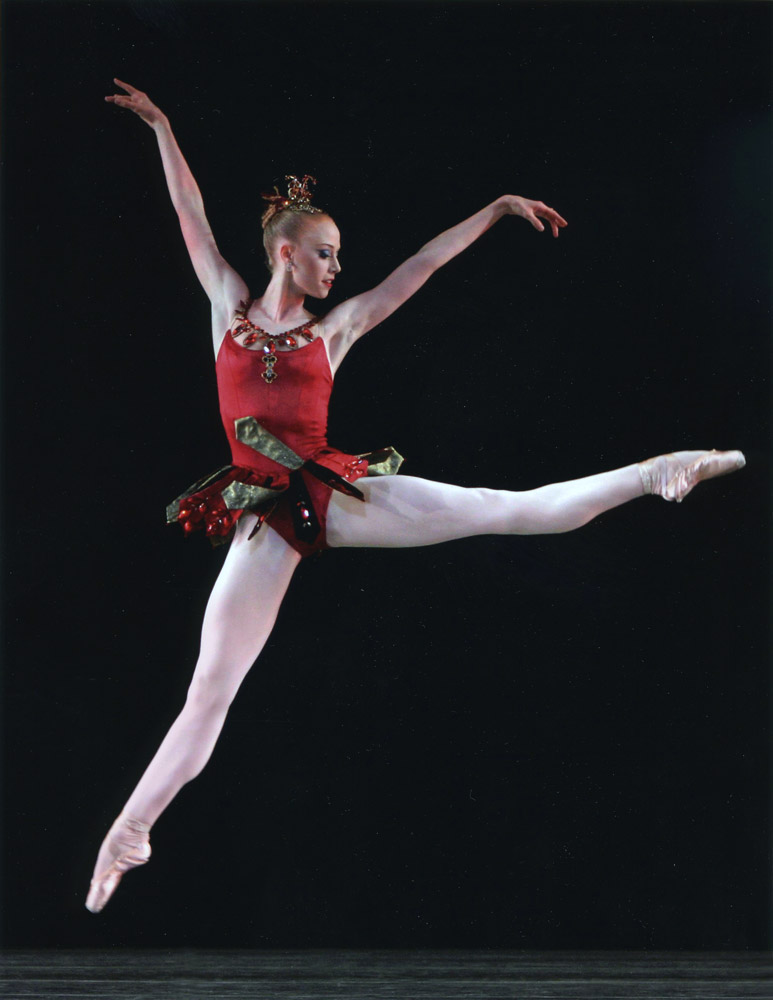
© Paul Kolnik. (Click image for larger version)
I’ve noticed a change in your dancing this season; you’re dancing with a new amplitude and freedom.
It’s been a big season for me. I’m going through a lot of personal stuff right now, which has brought about a reawakening for my love for ballet. I’m on an emotional roller-coaster, and ballet is a great outlet for that. I’ve been letting my emotions come out more onstage and in life too. But also, I feel like I’ve finally reached a point of comfort and assuredness in my dancing. I was a soloist for a long time and for a while I was unsure of my talent and worthiness. I was obsessing over technique and performing steps correctly. I think soloist is the hardest rank because you immediately lose all your corps parts but you’re not yet a principal so you’re third or fourth in line for roles. It’s a hard position to be in. I felt there was a lot of pressure on every single performance.
How did you overcome those feelings?
Mainly on my own. I went through a stage where I felt I was done with dancing. I was so unhappy I wanted to leave. I even talked about it with my parents. At that point I changed my approach to dancing because I thought, ok, I need to enjoy this time. About a year before I got promoted, I made a plan that I was going to dance another year and save up and take as many college courses as I could while I was making money. I realized that I needed to go out there and enjoy myself as much as I could, and I didn’t care what anyone thought of what I was doing onstage because in my mind it was the end, so it was all for me. I fully embraced every aspect of it. Few other jobs allow you to be around live music all day and do amazing choreography. So I made the most of every moment onstage. And my performances improved as a result. Before that point, I had allowed myself to get psyched out by the technical aspects. That’s the kind of person I am. I’m interested in science and I like to home in on details.

© Paul Kolnik. (Click image for larger version)
I feel like I saw that new freedom in your performance of Balanchine’s Tchaikovsky Piano Concerto No. 2 (a.k.a. Ballet Imperial).
I love that piece. I danced the soloist girl for years. When I got to do the ballerina role it was like the biggest gift I’d ever been given. You’re exhausted afterwards, but you’ve relished every minute. It’s got everything: footwork, jumps, turns. You have to be lyrical, but you also have to be dynamic and strong. It also has a lot of solo work: there’s so much you have to do on your own without relying on your partner. I guess I feel like I have a little bit of freedom in that role because the first time I did it I worked on it for so long. I was coached by Merrill Ashley for months. It was a big role for me at the time and I didn’t have a lot else so I had time to work on it.
Why did you start dancing?
I’ve always done it, from before I can remember. It was my favorite part of the day, always. I was naturally drawn to other dancers. I have three brothers. My grandmother tap-danced; she was offered a job with the Rockettes but her dad wouldn’t let her take it, and my mother wanted to dance but never did. I started classes when I was three.
What was your first experience of being excited by a dance?
I have a really vivid memory of seeing Alvin Ailey at the Kennedy Center, in Revelations. That was the first exhilarating, moving performance that I remember. I was probably twelve.
What sustains you?
I think it’s the challenge of it and the fact that I’ve always enjoyed moving and being active. And it’s a never-ending challenge.
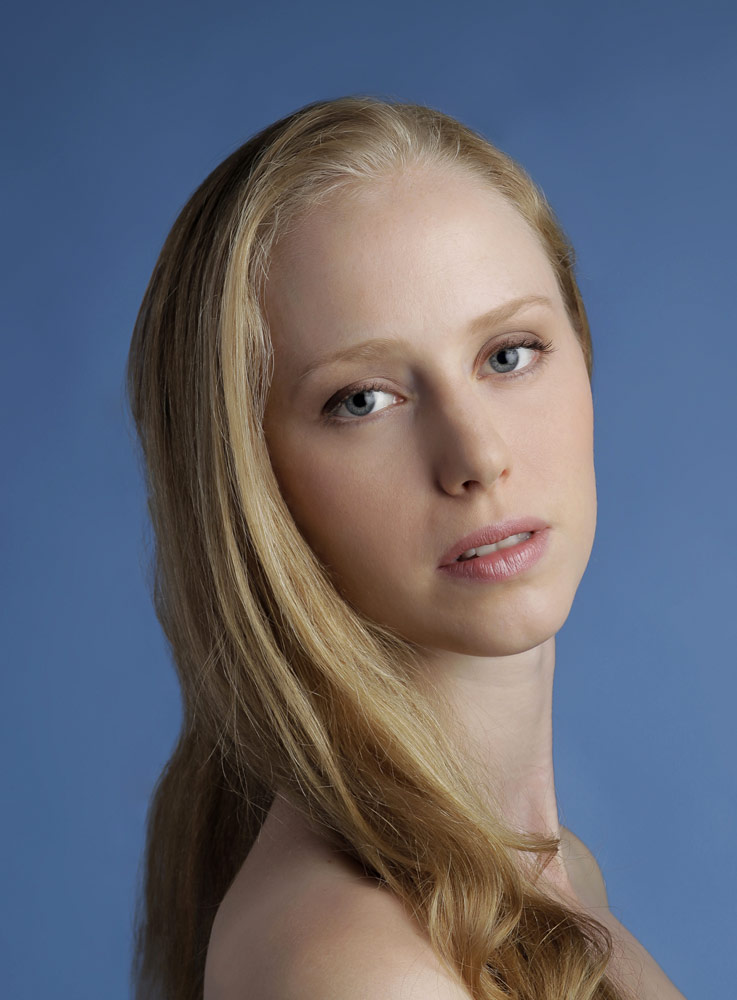
© Paul Kolnik. (Click image for larger version)
How did you come to the School of American Ballet?
I left [my ballet school in Virginia] when I was fifteen. I’d already been at the top level for three years. I needed more challenges, more stimulation. My parents identified that I could possibly succeed so there wasn’t really a choice. I loved being at SAB. Other than being incredibly homesick, I loved it; I loved being surrounded by ballet.
Was it very competitive?
I think it was competitive but I wasn’t competitive so I didn’t participate in it really. I was only there for a year, in the second highest level, because I got my apprenticeship very early. I was incredibly lucky because it was all given to me very easily. I was offered a job before I really had to fight for the few spots there are. I was sixteen.
When did you discover Balanchine?
At SAB. They give you tickets to shows and I would go every opportunity I had. Plus, Balanchine is this enigma that everyone talks about at SAB. You’re immersed in it. But it took me a long time to get the speed and clarity, and bending more. It’s a challenging technique. Sometimes it’s a struggle for me, as a tall dancer, to keep up with the tempos. I felt like for the first eight or nine years of my career I was always late. I’m surrounded by people, like Tiler Peck, who are so musical. They inspire you to be better.
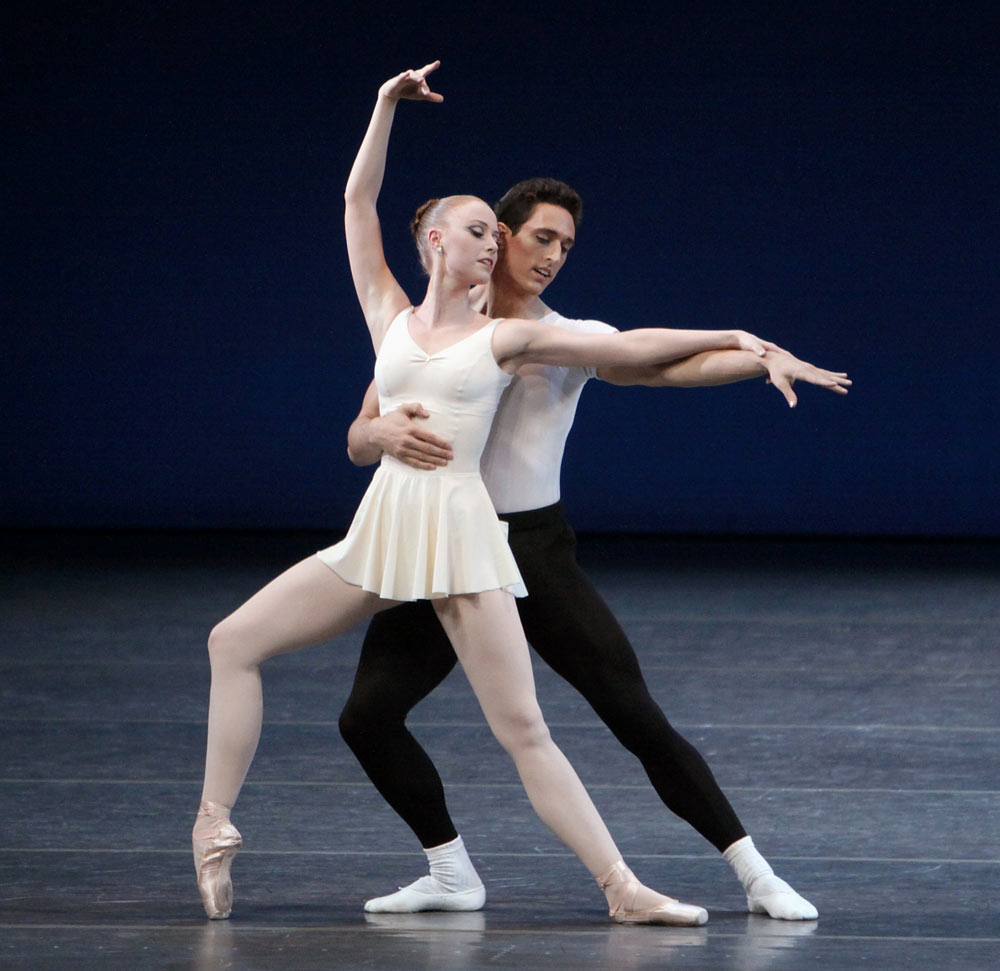
© Paul Kolnik. (Click image for larger version)
Are there particular composers whose music you enjoy dancing more than others?
I’ve always loved dancing to Stravinsky, and I think maybe I had never identified how much I love Tchaikovsky until this season. [The winter season was at NYCB was a “Tchaikovsky Celebration.”] Stravinsky is fun to dance to because of the syncopation; you always have to be alert and very focused, you can’t just listen to the melody. But you don’t count a Tchaikovsky ballet, you just dance the music.
You had your début in the adagio movement of Symphony in C last season. What was that like?
It’s such an iconic role, so it’s a little scary. Just knowing who’s danced it before you. You have to have 150% complete trust in your partner. And it’s all about the two of you dancing together.
Do you feel like you’ve cracked it?
Not yet. It’s hard for me because I don’t do much adagio stuff. In the past I did more powerhouse roles. It’s something I’m learning. Like in Swan Lake, the third act was much easier for me, because I’m more used to that kind of dancing, more dynamic and powerful.
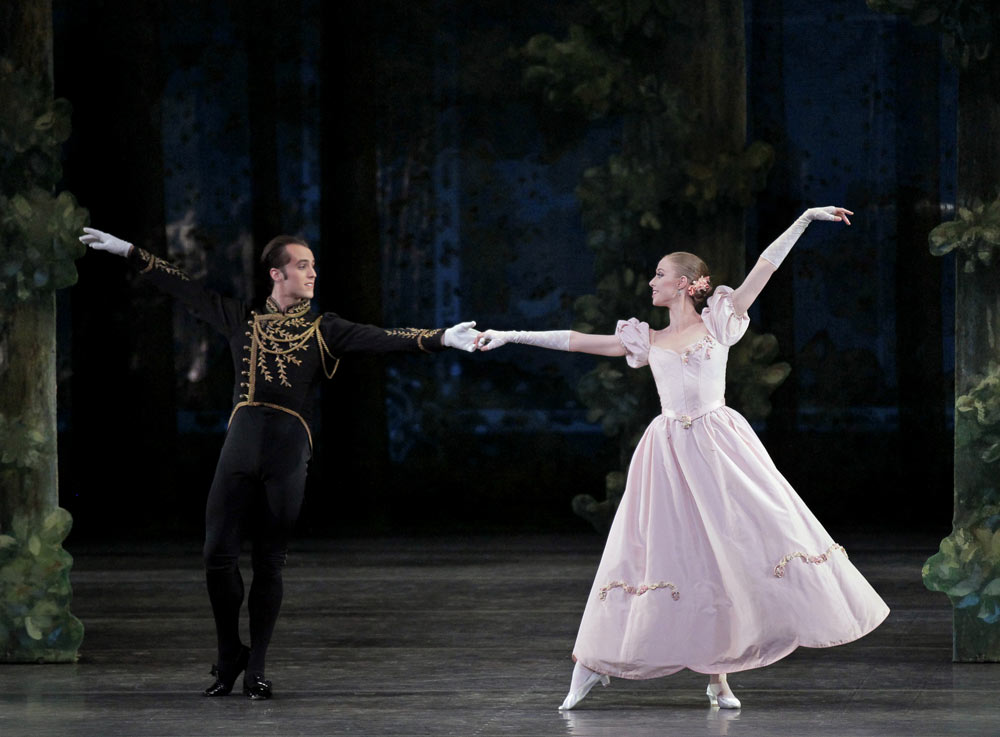
© Paul Kolnik. (Click image for larger version)
Do you create a story for yourself when you’re onstage?
Yes. I try to change the story every time I go out. But it’s hard to do the first time. Maybe I have to get a few performances under my belt before I start playing with it.
Do you look outside of the company for coaching or technical advice?
Coaching is useful for everyone, but I trust City Ballet and Peter [Martins’] judgment. There are definitely outside teachers whom I’ve learned a lot from, like Willy (Wilhelm) Burmann. I hear him in my head even when I’m taking other people’s classes. He has a way of disguising what everyone else is telling you. He uses tricks, like putting your arms in different positions during turns. You can identify what it’s forcing you to do, but you’re not thinking about it.

© Paul Kolnik. (Click image for larger version)
Have you ever been involved with the recording sessions for the Balanchine Video Archive, where the original interpreter of a role passes on the information he or she received from Balanchine?
I did Hippolyta in Midsummer Night’s Dream with Gloria Govrin. I think it’s fascinating to see the evolution ballets go through. There’s an ongoing debate at the company among the ballet masters about which version is the version. Because when Balanchine was around there were different versions. It can also be frustrating, because everyone is so emotionally and personally invested in the art form. The Balanchine Foundation video sessions are great, but what you do there is not necessarily what you are allowed to do onstage. But you can take some details. I think just being in the room with Govrin, because she’s such a powerful person, helped me envision her as myself. Balanchine definitely knew how to use her specific talents, like her jumping ability.
Do you ask a lot of questions when learning a role?
I think I learn a role and then ask a lot of questions after. Sometimes I ask more questions once I’ve done a role for a while.
Do you have a favorite partner?
I love dancing with Tyler Angle, and Ask la Cour and I are the most comfortable with one another. Tyler is just an amazing partner, and I love him as a person too, we’re great friends. He can sense where you are even before you know. He’s always there, and he’s so attentive. He invests himself in all the roles. It’s nice to be out there with someone who’s really in it. He’s very much into the process of making sure you’re telling the same story together. And he appreciates and loves music, so I feel I can learn a lot from him. He’s really into opera and music and he and his brother are pretty accomplished pianists.
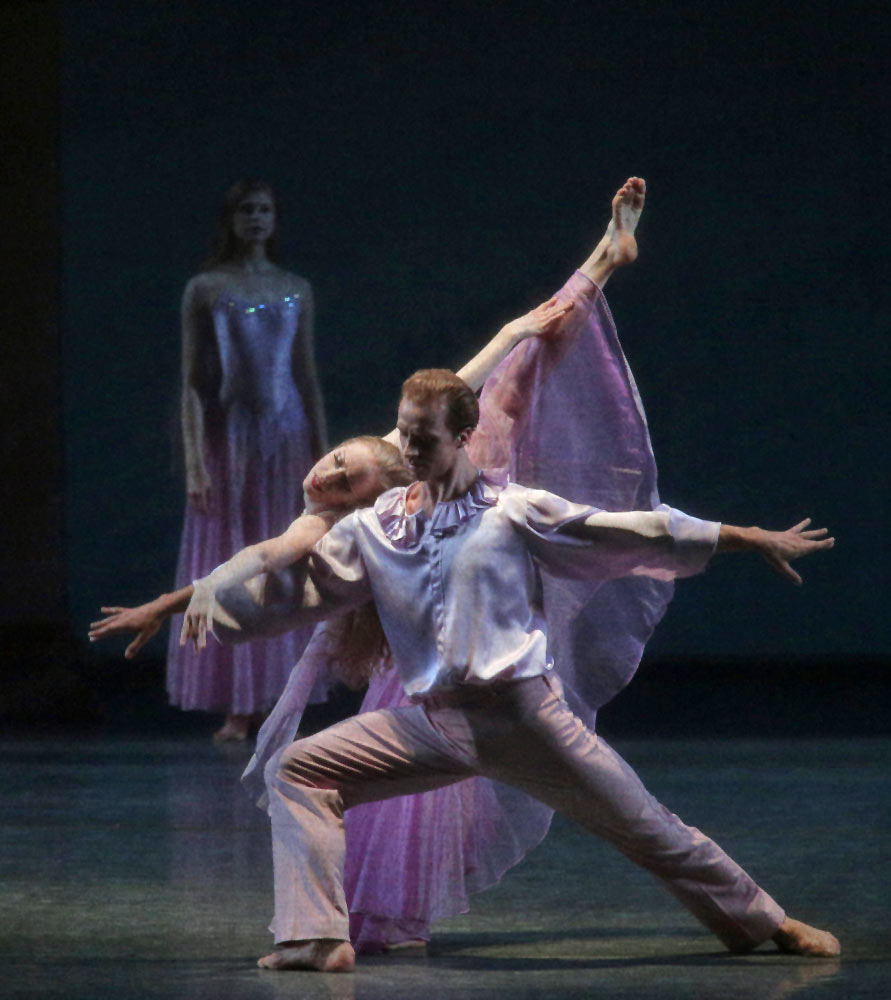
© Paul Kolnik. (Click image for larger version)
What choreographers have you worked with or would you like to work with?
I’ve done a lot of Justin Peck’s stuff and I enjoy it. He’s very good at homing in on a dancer’s strengths and pushing them beyond what they thought they were capable of. I desperately want to be in one of Ratmansky’s ballets. Because of timing, it’s never worked out. I always enjoyed working with Mauro Bigonzetti; he’s such a kind person in the studio. He gets dancers to move out of their comfort zone. And I’ve always had the desire to work with William Forsythe. I know the company asks him to come, but his obligations are to his company first, which I respect. But I still want to work with him. (Laughs.)
Do you see other kinds of dance?
I love Cedar Lake. I saw Pina Bausch and enjoyed that because it’s so different from what we do, so striking. I’ve been really into opera lately. I just saw Rigoletto at the Met. I saw Maria Stuarda. I loved the production aspects but I wasn’t crazy about the music. I like the Met’s whole esthetic of modernizing the art form and reaching out to younger audiences.
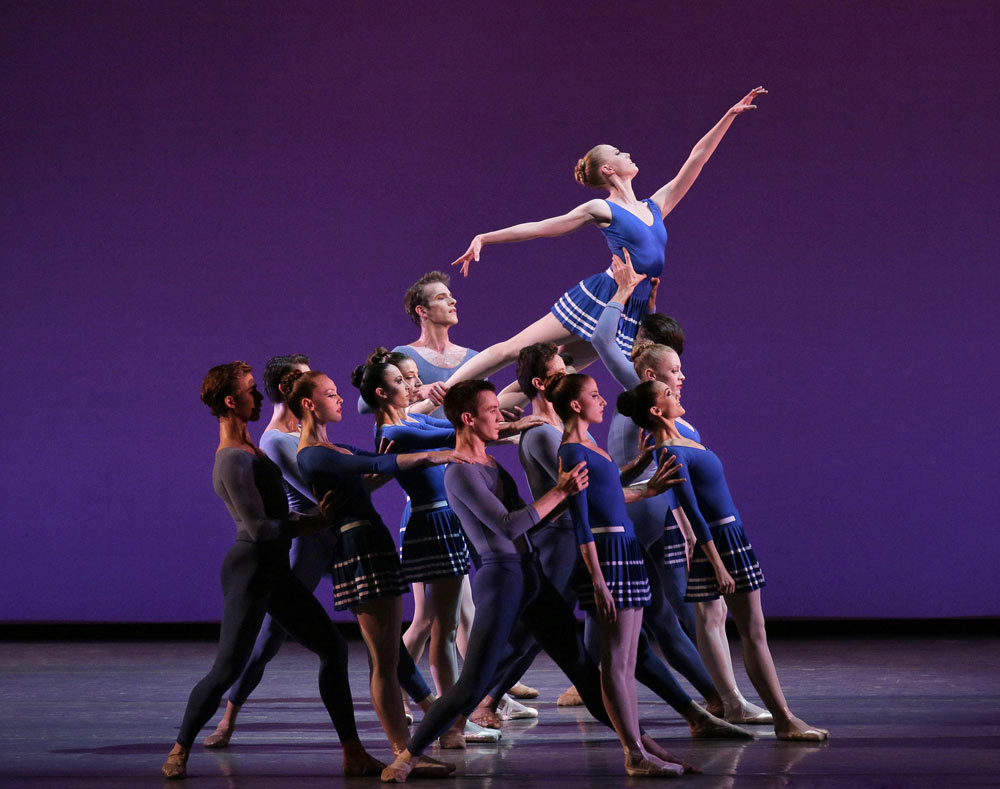
© Paul Kolnik. (Click image for larger version)
Is there a lot of excitement about having a rising choreographic talent like Justin Peck in the company?
Definitely. It’s always nice to have one of your own succeed. We’re all so fortunate because he’s an intelligent choreographer and he’s aware of the struggles of ballet as an art form and he’s trying to do things to invigorate it and bring youth in by using young contemporary composers like Sufjan Stevens who have fan bases outside of the world of ballet. That’s exciting for everyone. I think he loves this company and the mission of this company, so I hope he’ll stay.
Do you read reviews?
Yes. We get surprisingly little feedback at work sometimes, and I take everything with a grain of salt – I know it’s one person’s point of view – but sometimes there are things you can take out of a review. It’s information. I like to know what people are thinking. If there’s something I can take from them, I take it, if not I let it go.
Sleeping Beauty is coming up. What is it like dancing Lilac Fairy?
It’s unusual for our company because it’s a full-length. I prefer the one-act ballets, but it’s a good change of pace, and it’s fun to tell a story sometimes. Lilac Fairy is especially challenging because of all the pantomime. You’re kind of the narrator for the whole two and a half hours. I’m a little uncomfortable doing pantomime because it’s so unfamiliar and we don’t have any training for it. It’s also a challenge playing a character who’s all good. Most characters have a little bit more diversity in their moods. I see her as a guide or a guardian angel for the prince and Aurora.
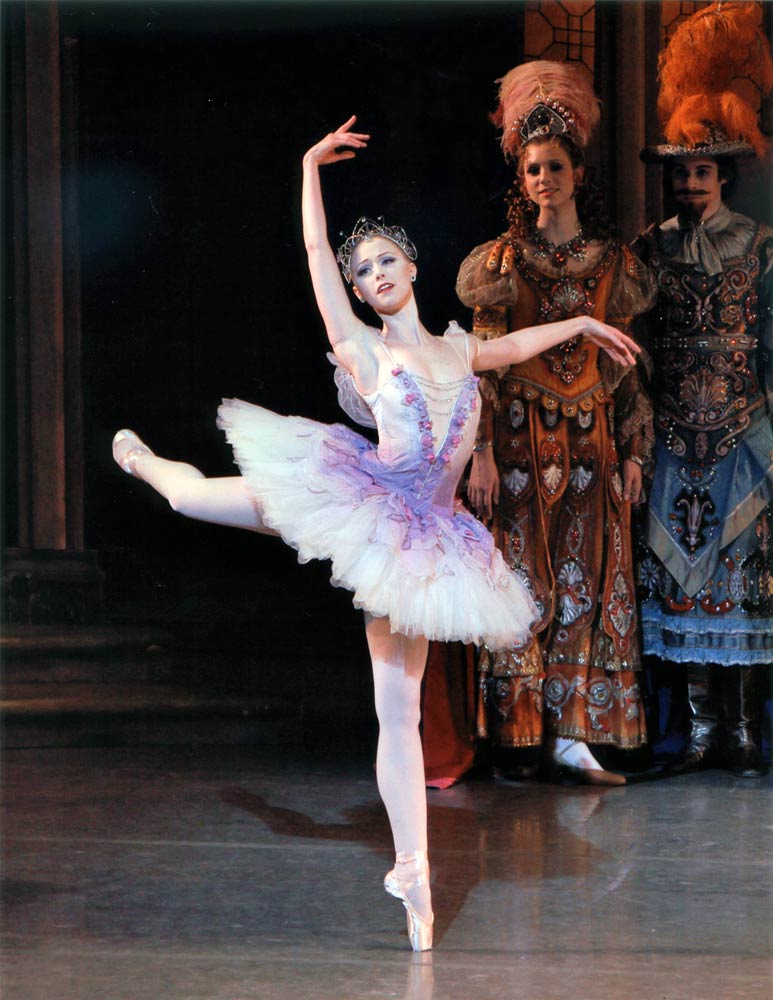
© Paul Kolnik. (Click image for larger version)
Do you think that this emotional moment you’re experiencing in your life has changed you as a dancer?
I didn’t realize I was capable of having my true emotions come out onstage, but it’s been very cathartic. I’m lucky it happened at this moment, during a Tchaikovsky season, so I could really delve into the emotions in the music. I hope I can hold onto that feeling. It’s been a sad period for me, but I want to remember how I opened up onstage and continue to feel that, no matter where I am personally. I’m letting myself really feel things onstage. I’m a reserved, guarded person, and I was scared to go there, but now I’ve been forced to go there. It’s scary to open yourself up like that in front of 3,000 people, but then you do it and it’s not so scary.






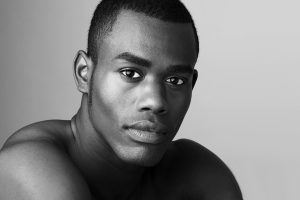




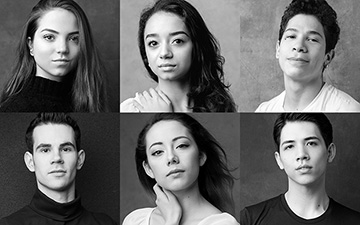

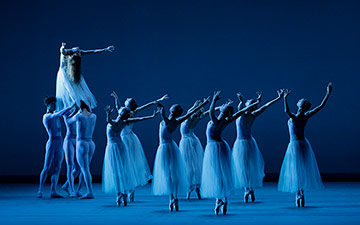

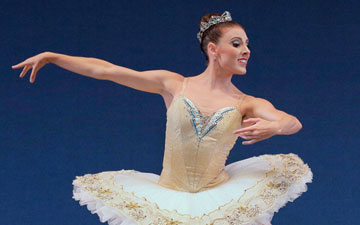

[…] sat down with Teresa Reichlen, of New York City Ballet; here‘s a link to my interview, for […]
Thanks again for an insightful interview with an NYCB dancer, Marina. It’s nice to read an interview that asks more probing questions that allow us to see who the dancers really are.
Thanks to Tobi for this interesting interview and many thanks for Teresa for being so open. The pull between being guarded (careful) and letting go (emotional) is a hard one in any profession. Being on stage in such an exposed situation makes it even harder. Very nice to have Teresa articulate how she is dealing with this pull. Best of luck to her in her dancing career as well as her biology studies.
I’m glad you enjoyed the interview. I was really grateful to Ms. Reichlen for her insight into her career, and for her openness. And by the way, Sally, I too am a fan of Tobi (Tobias)! I take it as a compliment that you should get our two names mixed up!
Great article on a great and smart and beautiful young woman whom I adore. That skin, Oh My Lord. Perfect. jim